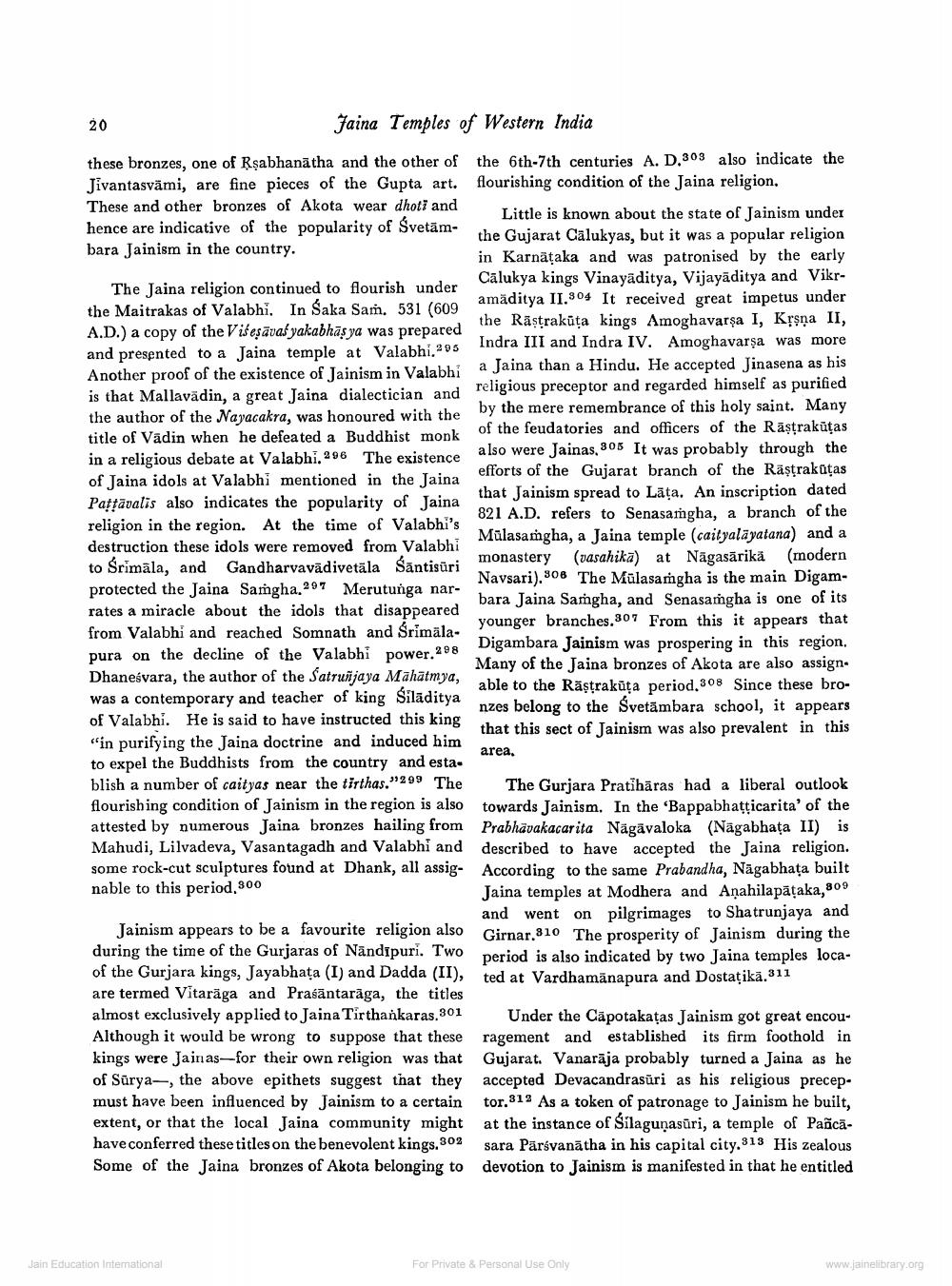________________
Jaina Temples of Western India
20
these bronzes, one of Rṣabhanatha and the other of Jivantasvämi, are fine pieces of the Gupta art. These and other bronzes of Akota wear dhoti and
Little is known about the state of Jainism under
hence are indicative of the popularity of Svetam- the Gujarat Calukyas, but it was a popular religion
bara Jainism in the country.
The Jaina religion continued to flourish under the Maitrakas of Valabhi. In Saka Sam. 531 (609 A.D.) a copy of the Viljaval yakabhaya was prepared and presented to a Jaina temple at Valabhi,295 Another proof of the existence of Jainism in Valabhi is that Mallavädin, a great Jaina dialectician and the author of the Nayacakra, was honoured with the title of Vädin when he defeated a Buddhist monk in a religious debate at Valabhi, 296 The existence of Jaina idols at Valabhi mentioned in the Jaina Paṭṭāvalis also indicates the popularity of Jaina religion in the region. At the time of Valabhi's destruction these idols were removed from Valabhi to Śrimāla, and Gandharvavadivetāla Säntisüri protected the Jaina Samgha.297 Merutunga nar rates a miracle about the idols that disappeared from Valabhi and reached Somnath and Srimalapura on the decline of the Valabhi power. 298 Dhanesvara, the author of the Satrunjaya Mahatmya, was a contemporary and teacher of king Siladitya of Valabhi. He is said to have instructed this king "in purifying the Jaina doctrine and induced him to expel the Buddhists from the country and esta blish a number of caityas near the tirthas."299 The flourishing condition of Jainism in the region is also attested by numerous Jaina bronzes hailing from Mahudi, Lilvadeva, Vasantagadh and Valabhi and some rock-cut sculptures found at Dhank, all assignable to this period, 800
Jainism appears to be a favourite religion also during the time of the Gurjaras of Nandipuri. Two of the Gurjara kings, Jayabhata (I) and Dadda (II), are termed Vitaraga and Praśāntarāga, the titles almost exclusively applied to Jaina Tirthankaras. 301 Although it would be wrong to suppose that these kings were Jainas-for their own religion was that of Surya, the above epithets suggest that they must have been influenced by Jainism to a certain extent, or that the local Jaina community might have conferred these titles on the benevolent kings, 302 Some of the Jaina bronzes of Akota belonging to
Jain Education International
the 6th-7th centuries A. D.303 also indicate the flourishing condition of the Jaina religion.
in Karnataka and was patronised by the early Calukya kings Vinayaditya, Vijayaditya and Vikramaditya II.304 It received great impetus under the Rastrakita kings Amoghavarsa I, Krupa II, Indra III and Indra IV. Amoghavarṣa was more a Jaina than a Hindu. He accepted Jinasena as his religious preceptor and regarded himself as purified by the mere remembrance of this holy saint. Many of the feudatories and officers of the Rāṣṭrakūtas also were Jainas, 305 It was probably through the efforts of the Gujarat branch of the Rāṣṭrakūtas that Jainism spread to Lata. An inscription dated 821 A.D. refers to Senasamgha, a branch of the Mulasamgha, a Jaina temple (caityalayatana) and a (modern monastery (vasahikā) at Nagasarikā Navsari), 308 The Mülasamṁgha is the main Digambara Jaina Samgha, and Senasamgha is one of its younger branches.307 From this it appears that Digambara Jainism was prospering in this region. Many of the Jaina bronzes of Akota are also assignable to the Raṣṭrakūta period.308 Since these bronzes belong to the Svetambara school, it appears that this sect of Jainism was also prevalent in this
area.
The Gurjara Pratihāras had a liberal outlook towards Jainism. In the 'Bappabhaṭṭicarita' of the Prabhavakacarita Nagavaloka (Nagabhața II) is described to have accepted the Jaina religion. According to the same Prabandha, Nagabhața built Jaina temples at Modhera and Anahilapāṭaka, 809 and went on pilgrimages to Shatrunjaya and Girnar.810 The prosperity of Jainism during the period is also indicated by two Jaina temples located at Vardhamanapura and Dostațikā.511
Under the Capotakaṭas Jainism got great encouragement and established its firm foothold in Gujarat. Vanaraja probably turned a Jaina as he accepted Devacandrasuri as his religious preceptor.312 As a token of patronage to Jainism he built, at the instance of Silagunasuri, a temple of Pancasara Parsvanatha in his capital city,313 His zealous devotion to Jainism is manifested in that he entitled
For Private & Personal Use Only
www.jainelibrary.org




